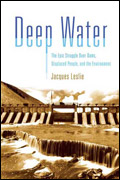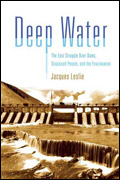What does hell look like to an environmentalist? In the classic Encounters With the Archdruid, writer John McPhee imagines this particular inferno. The outer ring, he writes, is a moat filled with DDT. Inside lies another moat brimming with burning gasoline, and still deeper are masses of bulldozers and chainsaws. In the middle — at “the absolute epicenter of hell on earth” — stands a dam. “Conservationists who can hold themselves in reasonable check before new oil spills and fresh megalopolises,” McPhee writes, “mysteriously go insane at even the thought of a dam.”

Deep Water:
The Epic Struggle
Over Dams, Displaced People,
and the Environment
by Jacques Leslie,
Farrar, Straus, and Giroux,
368 pgs., 2005.
This neat bit of fancy hit bookstore shelves in 1971, when big dams were still ascendant; at their global peak, in the early 1970s, nearly a thousand went up every year. In the decades since, dam fever has abated, thanks in part to widespread public opposition. Yet in some places, especially developing countries with large ambitions, big dams are far from forgotten, and they remain a mortal matter.
In his new book, Deep Water: The Epic Struggle Over Dams, Displaced People, and the Environment, journalist Jacques Leslie examines the modern battles over dams. His route into this broad and complex topic is a wonky one, but it works. Five years ago, the independent World Commission on Dams published a report titled Dams and Development; it acknowledged, to the surprise of many observers, that large dams are typically less profitable than predicted, cause irreversible environmental damage, and lead to “the impoverishment and suffering of millions.” In Deep Water, Leslie brings this dense document to life by picking three commission members — one anti-dam, one “mixed,” and one pro — and plumbing their minds and their work.
The result is a trio of lengthy profiles, packed with lovely details and useful insights. We first meet Medha Patkar, a Bombay-born former social worker who has dedicated her life to battling a series of huge dams on India’s Narmada River. The dams, already partially constructed, block “what may be the most revered river in the world,” as Leslie writes, and have already inundated entire tribal villages. Patkar and the other members of her group, Narmada Bachao Andolan, have an ascetic sensibility and an intense sense of purpose; hell on earth is straight ahead, and these activists have nothing to lose. Years of Andolan hunger strikes and other protests eventually forced the World Bank out of the Narmada project, an iconic victory for the Andolan campaign and others like it. But the Indian government soon vowed to provide the remaining funding for the dams, and even Patkar’s threats to drown herself in the rising reservoir have not stopped the project.
In the face of the gravity of his subject, Leslie is an appealingly modest guide. He confesses to embarrassment about drinking bottled water in front of Patkar, and to his own culture shock as an American in India. But he remains at a slight distance from his subject, and from that distance he gains clarity: Patkar is a powerful force, he finds, but no saint.

Dam, I wish I was your levee.
Equally moving, for different reasons, is Leslie’s portrait of anthropologist Thayer Scudder. Scudder has spent his career studying the “resettlement” of people displaced by large dams in Africa, and has come to believe that involuntary resettlement is “the worst thing you can do to people other than kill them.” But even in the face of stunning human tragedies, Scudder remains optimistic, insisting that the problems lie not with dams themselves, but in the policies that govern them. “His career could be read as a struggle to reconcile his belief in dams with the accumulating evidence of their failures,” writes Leslie, who traveled with Scudder in southern Africa. Ultimately, we find Scudder praising a proposed project in Laos, still searching for the elusive “good dam.”
The final profile, of Australian water manager Don Blackmore, is quieter than its predecessors. The Murray River, the largest channel in Australia’s only major river system, has been completely transformed by a series of large and small dams; its floodplains are studded with dead trees, and the once-lush estuary at its mouth has all but disappeared. Blackmore champions a “healthy, working river” — a river that still supplies irrigation water to basin farmers, but also regains some semblance of its natural flows. Striking that balance requires considerable diplomatic talent, and Leslie gamely tracks Blackmore’s intricate negotiations. But despite Leslie’s frequent reminders of the grand ecosystem at stake, stale meeting rooms and technical details slow his story down.
In this lack of drama, however, lies evidence of progress. Though ostensibly “pro-dam,” Blackmore spends his time seeking improvements, working to accommodate both nature and people in a framework that excludes most of both. He’s no Floyd Dominy, the famously profane U.S. Bureau of Reclamation commissioner portrayed in Encounters With the Archdruid. Dominy felt no such need to accommodate: without its dams, he snarled, the Colorado River “wouldn’t be worth a good goddamn to anybody.”
No dam advocate in Deep Water speaks so plainly, or with such bullheaded confidence. Perhaps the change in attitude is proof of changing values; perhaps it’s a tacit acknowledgement of the power of nature. Dominy lived in a time of young dams, when it was all too easy to assume, as Leslie writes, that technology “will redeem our sins.” Today’s dam builders may still dream big — witness the Narmada — but the dams of previous generations are aging, and leaking, and filling inexorably with silt. Arrogance no longer comes so easily.



